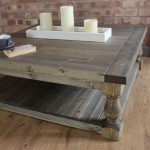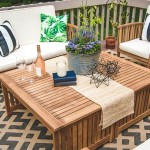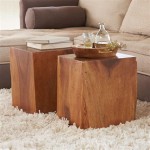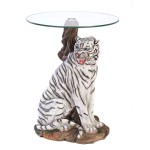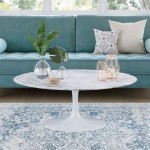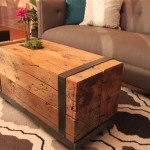Determining the Ideal Thickness for a Tempered Glass Table Top
Tempered glass table tops offer a sleek, modern aesthetic and are favored for their durability and ease of cleaning. However, selecting the appropriate thickness is crucial for ensuring the table's structural integrity and safety. A table top that is too thin may be prone to breakage under stress, while an excessively thick top may be unnecessarily heavy and costly. Several factors influence the optimal thickness, including the table's size, shape, intended use, and support structure. Understanding these variables allows for informed decisions regarding the glass thickness, leading to a functional and visually appealing table.
The primary advantage of tempered glass is its enhanced strength compared to annealed glass. Tempering involves a process of heating and rapid cooling, creating compressive stress on the surface and tensile stress within the core. This treatment dramatically increases the glass's resistance to impact and bending. When tempered glass breaks, it shatters into small, relatively harmless fragments instead of sharp, jagged shards, significantly reducing the risk of injury. This safety feature is particularly important for table tops, especially in households with children or in commercial settings.
Key Factors Influencing Tempered Glass Table Top Thickness
Determining the appropriate thickness of a tempered glass table top requires careful consideration of several key factors. These factors relate to the specific application, design, and intended use of the table. Ignoring these variables can lead to structural problems and potential safety hazards.
1. Table Size and Shape: The dimensions of the table top are directly proportional to the required thickness. Larger tables necessitate thicker glass to maintain structural integrity and prevent excessive flexing. A small side table with a diameter of 24 inches, for instance, would require a thinner glass top than a large conference table measuring 72 inches in diameter. The shape also plays a role. Rectangular or square tables with unsupported edges are more susceptible to bending than round or oval tables with continuous support. Irregular shapes with protruding sections or cutouts may require even greater thickness to compensate for stress concentrations.
The span of unsupported glass is a critical factor. If a rectangular table top has only four corner supports, the central area is unsupported, and the glass must be thick enough to bridge this gap without bending excessively. In contrast, a similarly sized table with a full perimeter support frame will require less thickness because the load is distributed more evenly. The longer the unsupported span, the greater the stress on the glass and the thicker it needs to be.
2. Intended Use and Load Capacity: The anticipated weight and use of the table will significantly impact the required glass thickness. A purely decorative coffee table intended only for light objects such as magazines and remote controls can utilize a thinner glass top. However, a dining table that will regularly support heavy dishes, serving ware, and potentially leaning individuals requires a much thicker and stronger glass top. Similarly, a desk used for writing and computer work might necessitate a medium thickness, depending on the weight of equipment placed upon it.
Consider the potential for impact loads. Will the table be used in a high-traffic area where accidental bumps are likely? Will it be subjected to frequent placement of heavy objects? These scenarios demand a thicker glass top to withstand the increased stress and prevent breakage. It is always prudent to overestimate the potential load rather than underestimate it, ensuring a greater margin of safety and longevity.
3. Support Structure and Frame Design: The type of support structure beneath the table top significantly influences the load distribution and, consequently, the required glass thickness. A table with a full, continuous frame provides the most support, distributing weight evenly across the entire surface. This allows for a thinner glass top compared to a table with only isolated legs or minimalist support points. Tables with multiple independent legs offer more support than those with a single pedestal base, but even distribution among the legs is essential.
The material and construction of the support frame also impact the overall stability. A rigid steel frame provides more support than a flexible wooden frame. The frame should be designed to prevent any twisting or racking, which could transfer uneven stress to the glass and increase the risk of breakage. The points of contact between the frame and the glass should be smooth and even to avoid creating localized stress concentrations.
In addition, consider the method used to secure the glass to the frame. Adhesive bonding provides continuous support and distributes stress more evenly than mechanical fasteners. However, the adhesive must be compatible with both the glass and the frame material to ensure a strong and durable bond. Mechanical fasteners, such as screws or clips, can create stress points if not properly installed or if over-tightened. The design should account for thermal expansion and contraction of the glass and frame to prevent stress buildup.
Common Thickness Recommendations for Tempered Glass Table Tops
While the ideal thickness depends on the specific factors outlined above, certain general guidelines can be used as a starting point. These recommendations are based on common table sizes and applications.
Thin (1/4 inch or 6mm): This thickness is generally suitable for small side tables, end tables, or decorative coffee tables with minimal load requirements. These tables should have either a small surface area or a full support frame. It is not recommended for tables that will bear significant weight or for tables with large unsupported spans.
Medium (3/8 inch or 10mm): This is a versatile thickness suitable for a wide range of applications, including coffee tables, dining tables, and desks. It offers a good balance between strength and weight and is appropriate for tables with moderate load requirements and moderate unsupported spans. This thickness is often chosen for general-purpose tables in residential and commercial settings.
Thick (1/2 inch or 12mm): This thickness is recommended for larger tables, conference tables, dining tables that will regularly support heavy loads, and tables with significant unsupported spans. It provides excellent strength and stability and is suitable for demanding applications where safety and durability are paramount. This thickness is often preferred for commercial settings and high-traffic areas.
Extra Thick (3/4 inch or 19mm and thicker): This thickness is typically reserved for specialized applications, such as very large conference tables, heavy-duty work surfaces, or tables with unusual shapes or support structures. It provides maximum strength and impact resistance and is often used in demanding industrial or commercial environments.
It is crucial to consult with a glass professional or structural engineer for specific recommendations, especially for tables with unique designs or unusual load requirements. The above guidelines serve as a general starting point, but professional expertise is invaluable in ensuring the safety and longevity of the table.
Ensuring Safety and Longevity
Beyond selecting the appropriate thickness, several practices contribute to the safety and longevity of a tempered glass table top. These involve proper installation, maintenance, and responsible use.
Proper Installation: Correct installation is crucial for maximizing the strength and stability of the table. Ensure that the support frame is level and stable before placing the glass on top. Use appropriate padding or spacers between the glass and the frame to prevent direct contact and reduce the risk of stress concentrations. If using adhesive bonding, follow the manufacturer's instructions carefully and allow sufficient curing time. If using mechanical fasteners, avoid over-tightening and ensure that the fasteners are evenly spaced.
Edge Treatment: The edges of the glass should be properly finished to prevent chipping and cracking. Common edge treatments include seamed edges, ground edges, and polished edges. Polished edges are the most aesthetically pleasing and also offer the greatest resistance to damage. Avoid sharp or unfinished edges, as these are more susceptible to impact and breakage.
Regular Maintenance: Clean the glass regularly with a mild detergent and a soft cloth to remove dirt and grime. Avoid using abrasive cleaners or scouring pads, as these can scratch the surface. Inspect the glass periodically for any signs of damage, such as chips, cracks, or scratches. If any damage is detected, consult with a glass professional to determine the appropriate course of action. Promptly address any issues to prevent further damage and potential safety hazards.
Responsible Use: Avoid placing excessively heavy objects on the table or subjecting it to sudden impacts. Distribute weight evenly across the surface and avoid concentrating loads in one area. Use coasters or placemats to protect the glass from heat and spills. Instruct users on proper handling and care to minimize the risk of damage. By adhering to these guidelines, you can ensure the safety and longevity of your tempered glass table top.

Table Top Tempered Glass

Fab Glass And Mirror 20 In X 40 Clear Rectangle Table Top 1 2 Thick Flat Edge Polished Tempered Radius Corner T 20x40rec12thf The Home Depot

3 8 Thick Round Glass Table Top Pencil Polish Tempered 36 Inch

20 X 24 Rectangle Glass Table Tops

Fab Glass And Mirror 24 In X 36 Clear Rectangle Table Top 3 8 Thick Beveled Edge Polished Tempered Radius Corners 24x36rect10thbe The Home Depot

1 2 Thick Round Glass Table Top Flat Polish Tempered 60 Inch

Fab Glass And Mirror America S Premier With Match Guarantee

Fab Glass And Mirror 36 In Clear Round Table Top 3 8 Thickness Tempered Beveled Edge Polished 36rt10thbete The Home Depot

Fab Glass And Mirror America S Premier With Match Guarantee

Round Tempered Glass Table Top 1 4 2 3 8 Thick Flat Beveled Polished Edge
Related Posts

